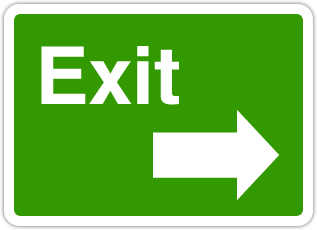Usage Lifecycle: What are your user’s exit points?
Exit points are the critical points at which you lose valued users. Are you keeping track of yours?
Exit points are the critical points at which you lose valued users. Are you keeping track of yours?
Andrew Chen, who writes the excellent blog Futuristic Play, has a nice post explaining exit points, those point in which people decide to leave your product/service/app: 25 Reasons People Stop Using your Product

Exit points really resonate with me because they are clearly part of the Usage Lifecycle, the lifecycle that users go through as they use your product or service. What makes the lifecycle useful is that it focuses us (the designers) on the major hurdles of use such as sign up, getting started, and ongoing engagement.
Going down another specificity level from hurdles are exit points. As Andrew explains:
“In the customer lifecycle perspective, you look at the product from the perspective of a user that has a series of experiences starting from newbie and going into an advanced role. In addition to looking at the success cases, looking at the failure cases is informative too – you want to analyze your product for potential exit points and relate them to both quantitative and qualitative measures.”
Here are some examples of exit points:
- “I don’t understand how this is valuable to me”
- “I don’t have any friends here”
- “I only use this site to manage contacts, not do anything productive”
- “This site is too distracting”
- “I keep getting messages from people I don’t know”
- “It’s not worth the effort”
Exit points don’t get enough attention. In my experience they’re remarkably stable across a population for a given service. In other words, there will be common exit points that your users have…there will be clear trends that you can design to prevent. The problem is that these exit points aren’t always visible, and here’s the key issue: exit points often don’t happen while someone is using your software. In fact, exit points can occur when someone is far away from your product.
While they’re relatively stable within a product, exit points are different for every product. And they are very specific, having to do with the context of use. Additionally, exit points are different depending on what stage of the lifecycle someone is in. If they are using an application for the first time, for example, they are going to have different exit points than when they’re a long-time user. Other things to note about exit points:
- These trouble spots aren’t necessarily interface design issues
- They can happen away from the service, merely in the mind of users
- They happen because of the behavior of others
- They are sometimes a decision based on lots of interactions, not a single one
- Sometimes they’re nothing more than passing fancy
Some exit points are vague and difficult to design for (“It’s not worth the effort”). You might need to get more information before knowing what to do design-wise. But others are easier to design for (“I don’t have any friends here”).
Do you know what your exit points are? Are you keeping track, watching trends, and designing to prevent them?
Previous